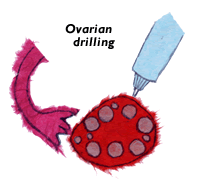The ovarian drilling is usually performed during laparoscopy. In this procedure, an electrosurgical needle or a laser fiber punctures the ovary for four to ten times. This treatment results in a dramatic reduction of male hormones within days. Usually this procedure is performed in women suffering from polycystic ovary syndrome (PCOS). As per the studies, nearly 80 percent of patients benefit from this treatment.
Women who fail to ovulate with Metformin therapy or clomiphene will respond well to these medications after undergoing ovarian drilling.

How does ovarian drilling work?
The laparoscopic ovarian drilling is a surgical treatment that triggers ovulation in women suffering from PCOS (polycystic ovary syndrome). In this process, a laser will be used to destroy some parts of the ovaries. Although this surgery is not used commonly, yet this is an option for women who are trying fertility medications or for those women who are still not ovulating after losing weight.
Usually, the ovarian drilling is performed through a small incision with the help of a laparoscopy. The patient will be administered with a general anesthesia. Your surgeon will make a small cut at the belly button of the abdomen. Then he will place a tube such that it inflates the abdomen with a small amount of carbon dioxide gas. This will help him insert the viewing instrument also called as laparoscope without damaging your internal organs.
The surgeon will then look at the internal organs with the help of the laparoscope. Then he will insert his surgical instruments either through the same incision or through the other small incisions made in the pelvic area. The size of the incisions are so small that the laparoscopy is also called as “Band aid surgery”.
Will ovarian drilling work for me?
If you are having PCOS (polycystic ovary syndrome) and having fertility issues, then your doctor will recommend you to undergo LOD (laparoscopic ovarian drilling). This is a minor surgical procedure which will treat the fertility problems in women having PCOS.
You will not know the happenings during this surgery, since you will be under general anesthesia. Your doctor will perform this surgery by making a small cut in the tummy and pass a long, thin microscope through it. Since the incisions created are very small, so there will be less scars after surgery. Also the recovery time required will be very less. Your hospital stay will also be reduced and you can resume your normal activities post surgery.
The laparoscopic ovarian drilling will lower the testosterone and the luteinising hormones (LH) and also boosts the FSH (follicle-stimulating hormone). In other words, this surgical procedure will destroy the tissues produced by the male hormones called androgens using laser or heat. Hence, LOD help to correct your hormonal imbalance, thereby restores the normal functioning of your ovaries.
Is ovarian drilling safe?
The ovarian drilling is quite safe. The side effects of this treatment are rarely reported.
Weighing risks and benefits:
The side effects of ovarian drilling are very rare. The risk factors related to complications during the laparoscopic ovarian drilling are ovarian failure or adhesion formation.
Benefits:
It is performed on women with PCOS who are unable to ovulate even after taking fertility medications or reducing weight.
This procedure helps to restore the regular ovulation cycles in women.
Women may be able to become pregnant after they undergo ovarian drilling surgery.
Conclusion:
Ovarian drilling is an effective treatment for women having fertility issues. It helps to regulate the normal function of the ovaries. This procedure is quite safe and aids women to become pregnant. India offers excellent ovarian drilling treatment at quite reasonable rates.
References:
- “What is Polycystic Ovary Syndrome (PCOS)?”. Verity – PCOS Charity. Verity. 2011. Retrieved 21 November 2011.
- Polycystic Ovary Syndrome Treatment in nhs.uk/Conditions/Polycystic-ovarian-syndrome/Pages/Treatment

